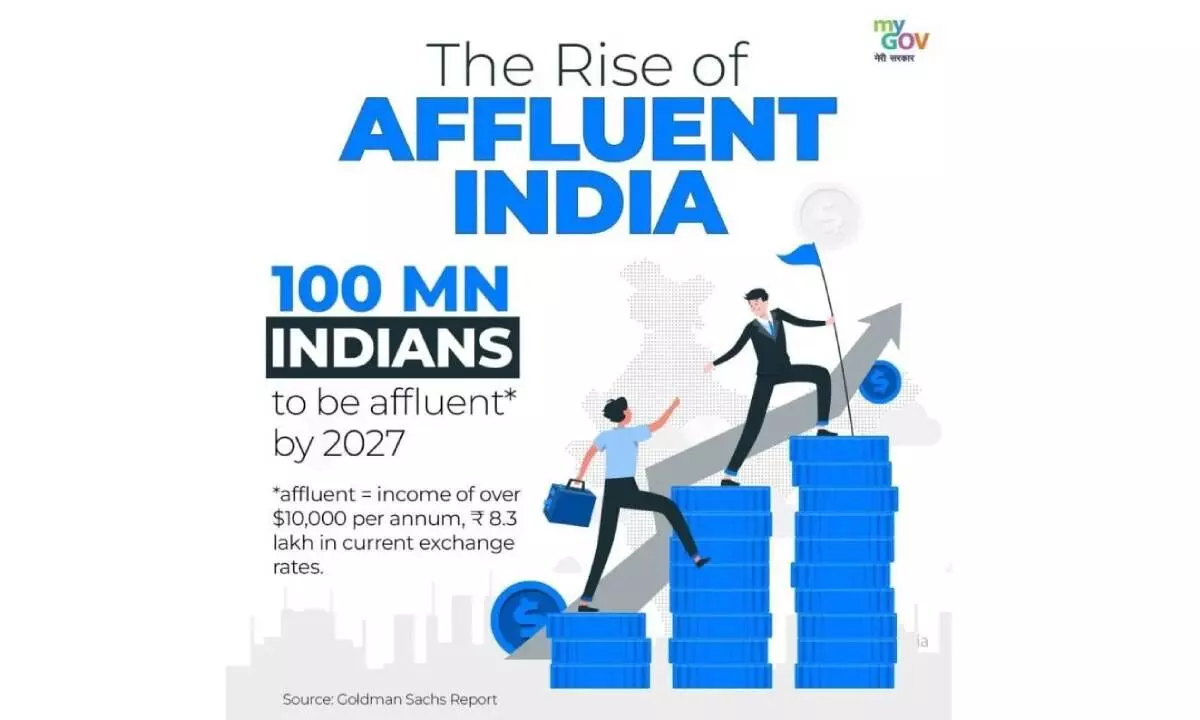Higher purchasing power and rising affluence takes India to new global high
The affluent cohort is poised to shape consumption trends and drive demand across sectors
image for illustrative purpose

The affluent population in India represents a segment of individuals or households endowed with substantial wealth or income compared to the broader populace. This demographic privilege commands notable purchasing power, enabling them to indulge in luxurious lifestyles marked by access to upscale goods, premium services, and opulent amenities. They are a prime target for marketers specializing in luxury brands and high-end commodities.
Forecasts from a Goldman Sachs report titled "The Rise of Affluent India" paint a vivid picture of this burgeoning demographic. Projections suggest a significant surge in affluence, with an estimated 100 million Indians set to join the ranks of the affluent by 2027, up from 60 million in 2023. This anticipated growth underscores a seismic shift in the economic landscape, with profound implications for consumption patterns and market dynamics.
According to the report, this burgeoning affluent class is expected to earn in excess of $10,000 annually, fuelling increased expenditure on travel, jewellery, dining, and leisure activities. As their economic influence expands, the affluent cohort is poised to shape consumption trends and drive demand across various sectors of the economy.
The report's insights are predicated on robust growth projections, with a compound annual growth rate of 12-13% observed between 2019 and 2023. Extrapolating this trajectory, analysts anticipate a substantial expansion of India's affluent populace by 2027, potentially exceeding even the conservative estimates.
In essence, the rise of India's affluent population heralds a transformative period of economic prosperity and cultural evolution. As this demographic ascends, its burgeoning wealth and consumption habits are poised to redefine India's socioeconomic landscape, exerting a profound influence on market dynamics and societal trends.
Mumbai has now overtaken Beijing as Asia’s billionaire capital for the first time with 93 members in the exclusive rich club, according to Global Rich List 2024, published by Hurun Research Institute.
According to the Shanghai-based institute, New York and London lead the cities with 119 and 97 billionaires, respectively.
Surpassing China's average wealth per billionaire ($3.2 billion vs $3.8 billion), Indian billionaires' cumulative wealth reached $one trillion, according to the 2024 Hurun Global Rich List.
Taking over China's 55 and solidifying India's position as the second-largest contributor to the global billionaire population, this phenomenal rise is mirrored by India's addition of 94 new billionaires in a single year.
India is now the third-ranked country globally with 271 billionaires, surpassing Germany. India's performance stands out whereas the number of billionaires globally increased by a modest 5%.
Adding the second-highest number of new billionaires (94) after the US (109), the country has witnessed a meteoric rise.
Surpassing Germany and signifying a potential shift in the global economic landscape, this surge catapulted India to the third position globally.
Mukesh Ambani remains Asia's richest person, but the real success lies in the sheer number of new entrants.
India boasts a remarkable 247 individuals who saw their wealth increase, far exceeding China's 241, with only 24 billionaires experiencing a wealth decline. A cumulative wealth surge of 51% in India is marked by this robust growth.
"Mumbai was the fastest-growing billionaire capital in the world, adding 26 in the year and taking it to third spot in the world and Asia's billionaire capital. New Delhi broke into the Top 10 for the first time," said the Hurun Global Rich List 2024.
The meteoric rise in India’s exclusive billionaire club was led by Reliance Industries chairman Mukesh Ambani ($115 billion) and Adani Group chairman Gautam Adani ($86 billion), who was helped by a 33% surge in wealth. Overall, the country has added 94 people to its list, taking the total to 271 ultra-high-net-worth individuals (UHNWI), the report said, adding that it was the highest since 2013. Mumbai has contributed 26 to the list.
This has come at a time when the country is witnessing a robust growth with the gross domestic product recording a 7.5% surge in 2023. Pharmaceuticals, automobile, automobile components and chemicals industry were some of the country’s sectors that dominated the UHNWI’s list.
The rise of an affluent population in India heralds significant implications for the nation's economy, permeating various facets of economic activity and shaping its trajectory in the years to come.
Thus, the burgeoning affluence in India augurs well for the economy, unleashing a virtuous cycle of consumption, investment, and market dynamism. As the ranks of the affluent swell, their economic influence will continue to shape consumption patterns, investment trends, and market sentiment, propelling India towards sustained prosperity and growth in the global arena.

